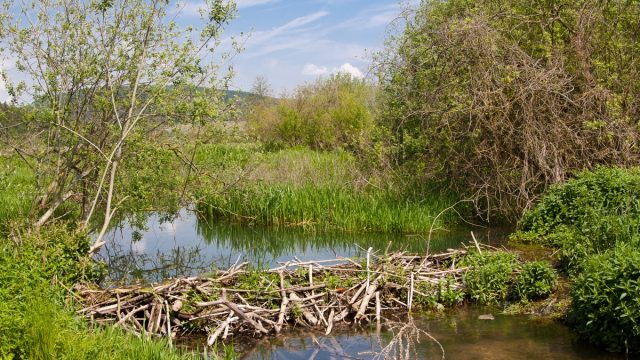This Is Why Beavers Build Dams

If you know one thing about beavers, it’s probably that they build dams. (Here are a few more things: These rodents are second only to humans in their ability to manipulate the environment, and the largest dam they’ve ever built is 2,790 feet long and can be seen from space.) But back to that whole dam thing. Why do beavers build dams? And how do they get the job done?
Turns out, the primary reason beavers build dams is to protect themselves from predators—pesky animals like bears, hawks, wolves, wildcats, and otters—and to secure easy access to food, especially during the colder months.
According to the Washington Department of Fish & Wildlife, beaver dams are built in shallow streams and rivers to create flooded areas known as beaver ponds. (Beavers that live in areas that maintain a steady water level, such as lakes and large rivers, build burrows instead of dams.)
It’s a complicated feat of engineering, but these animals are more than cut out for it. To build their dam, beavers choose their location and gnaw away at nearby trees and branches. Ideally, the wood falls directly into the river, cutting off the flow of water. Those pieces of wood create the basic structure for the dam. The beavers further fortify their new home by adding twigs, stones, leaves, mud, and plants to the mix to seal things up. The average dam is five-feet tall and 330 feet long—but these things can get as tall as 10 feet.
Nearby a beaver dam, you’ll find a beaver lodge. That’s where the beavers spend most of their time! Lodges are built into the banks of a stream or river. Similar to the dam, these dome-shaped structures are made of sticks, grasses, and mosses. They average around eight-feet wide and three-feet tall, and typically house a single family of beavers. (That includes a monogamous beaver couple, their offspring, and their offspring from the year before—usually about two to 12 beavers.)
But back to why beavers do all this.
First of all, if it weren’t for their dams, beavers would be fairly easy prey. “They are very agile in the water but they’re a bit slow moving on land,” Sharon Brown, a biologist from Beavers: Wetland and Wildlife, an educational organization in North America, told the Telegraph. “They create a habitat with lots of water like a moat around their lodges so they can swim and drive and keep one step ahead of predators.”
Second, these beaver-made ponds create unique ecosystems that can support certain aquatic plants the beavers can feed on. And in some cold-water environments, beavers use the deep, unfrozen water in their dam’s beaver pond to store branches of food trees and shrubs by digging them into the mud at the bottom of the pond.
These little guys love their homes. Typically, a beaver will stay in the same location until their food supply runs out, which could be a few years or a few decades. And since the animals live just five to 10 years in the wild, that means they often stay in the same place their entire lives. How’s that for having a favorite neighborhood? That doesn’t mean you should feel too comfy around them though. Beavers are also on the list of 23 Cute Animals That Are Way More Dangerous Than You Thought.
To discover more amazing secrets about living your best life, click here to follow us on Instagram!